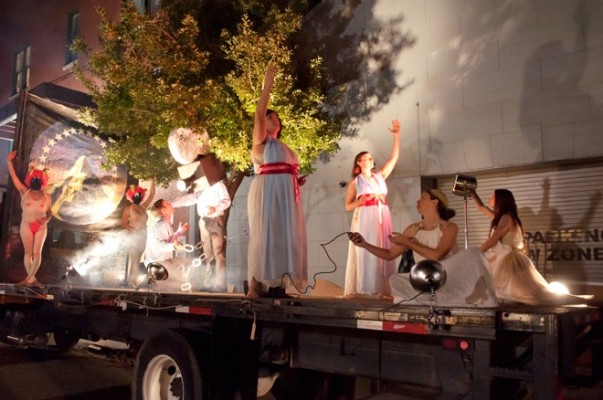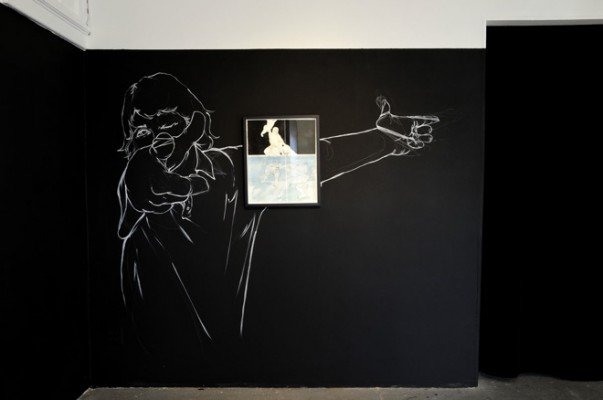Round Up: The Best of Prospect 1.5 New Orleans

Okay Mountain Collective, Water, Water Everywhere So Let's All Have A Drink, 2010. Video still frame. Courtesy the artists and Arthur Roger Gallery, New Orleans.
Okay Mountain Collective
Arthur Roger Gallery
432 Julia Street
December 4, 2010—January 29, 2011
With this satirical video installation, the Okay Mountain Collective places the viewer squarely in the seat of a bored channel surfer. A twist on the traditional sailor’s lament, Water, Water Everywhere So Let’s All Have a Drink, 2010, is equal parts commentary on media oversaturation and introspection of masculine longings, fears, and desires.
The 28-minute video runs as a continuous loop with a smattering of short vignettes designed after the collective’s own memories of television viewing. The hilarious renditions include everything from suggestive infomercials and nonsensical poker games with hushed commentary to a weatherman predicting his future marriage troubles and on and on. Subtle undertones of isolation, repressed sexuality, and crippling self-consciousness are ever-present, as are the flattened male archetypes so often seen on television—the self-important stand-up comic, the goading hypnotist, the mettlesome cowboy, the martial arts expert. One of the more obvious snippets—and our first and only encounter with a female character—is a self-deprecating mock exposé show where we meet “Former Intern” Nadine, who tells the interviewer of her struggles working in a “total boys’ club.”
Working together to script, act out, and create handmade props for each vignette, the collective consists of ten artists (nine male, one female) from all over the United States who exhibit independently and assemble periodically in Austin, Texas. Fittingly, this collaborative video installation feels like a boyishly absurd, yet witty collection of individual stories that holds a mirror to our mass media milieu. It’s a perfect example of the sum being greater than its parts, in that the barrage of imagery and lampoonery coming from a singular artist might seem—much like saltwater to thirst—insufficient.
—Lauren Scarpello

The New Orleans Society for Tableau Vivant performing Tai Shani's interpretation of Orpheus and Eurydice, 2010. Photo by Vaughn D Taylor.
“Tableau Vivant: A Wandering Retrospective”
Various Locations
November 6 and 13, 2010
Silent figures held their poses as the usual flash and blare of police sirens flew by. Mythic compositions of elaborately costumed characters moved slowly, telling a living story or, literally, a tableau vivant. On November 13, the New Orleans Society for Tableau Vivant, along with other guest artists, performed nine varying scenes from atop a flatbed truck advancing along St. Claude Avenue as part of Prospect 1.5. Tableaux vivants were popularized in the 19th century as entertainment at parties for the wealthy. When the original Mardi Gras krewe, the Mistick Krewe of Comus, organized the first ever night parade in New Orleans, their crepuscular tableaux vivants floated down the streets, leading the way toward the Mardi Gras balls. This art form’s profound connection to the city’s past and contemporary landscape, as exemplified by its presentation in the burgeoning St. Claude arts district, is what made me fall in love with the Society’s rolling delights.
Produced by New Orleans Airlift and carefully selected by British curator Rosie Cooper to educate the viewer, each successive scene recorded the evolution of the tableau vivant beginning with Hal an Tow, a play based in Celtic tradition dating to the 16th century. A brilliant history followed: The Metamorphosis of Ovid as presented in 1878 by the Mistick Krewe of Comus, Mercure, which was created by Pablo Picasso, choreographer Léonide Massine, and composer Erik Satie in 1924, and London-based artist Tai Shani’s translation of the myth of Orpheus and Eurydice as a current portrayal of Hollywood narcissism. In Anna Barham’s particularly beautiful interpretation of Proteus, four figures dressed in black gripped white polyhedrons recalling a Robert Morris sculpture. Airlift co-founder Delaney Martin concisely summed up the project saying: “Truly we pay tribute.” I was left wondering as to whether these tableaux signified a thoughtful history of the art form, an analysis of how our roots define our contemporary identities, or simply the mischievous work of a tipsy fairy. Perhaps the magic lies in some combination of all three.
—Tori Bush

Maximilian Toth, Installation at Good Children Gallery, New Orleans, 2010.
Maximilian Toth
Good Children Gallery
4037 St. Claude Avenue
December 11, 2010—January 2, 2011
The psychological impact of how art is presented is a notion not fully probed in New Orleans. The city is abundant—and ever growing—in galleries, yet much of the work that conforms to canvas or a frame is neatly hung in tidy, white-walled spaces. Artist Maximilian Toth’s Prospect 1.5 show at Good Children Gallery challenged the white-wall paradigm by filling the area surrounding his drawings and paintings with larger-than-life characters and scenes pulled from his storybook narratives of adolescents run amok. Was the artist extending his paintings onto the gallery walls, or were the walls serving as essential backdrops for unpacking Toth’s investigations of contemporary youth culture? In either case, by taking on the restrictions of the canvas and allowing the action to spill from the frame to the wall and back, Toth’s bold presentation gave ample credence to the subject of his work: the aggression of the suburban American male. Cow-tipping, arm-wrestling, and roman candle battles are a few of his characters’ preoccupations depicted through contrasting line drawings on either slate black or white backgrounds with sparse pops of color.
Born in New Orleans but raised around the suburbs of Concord, Massachusetts, Toth calls on his own biography for his “blackboard illustrations” representing the post-school excursions of boys who have spent their days strapped into school chairs. Freed from classrooms, they now pile over fences and squeeze into shopping carts. Agitation, anxiety, and bravado are summoned and moments are frozen with undiluted momentum. A mighty force of boyhood energy is unleashed and visitors are provided with a near-cinematic experience where action is given no resting place between frames.
—Adam Falik

Natalie McLaurin, Installation of They go all the way up at Madame John's Legacy, New Orleans, 2010. Photo by Jonathan Traviesa.
“Fresh Off the Turnip Truck”
Madame John’s Legacy
632 Dumaine Street
November 6, 2010—January 20, 2011
The Louisiana State Museum describes Madame John’s Legacy, a survivor of the 1795 New Orleans fire, as “the kind of home that prospering colonists built after progressing from their first rude cabin dwellings.” Coupled with the show title, “Fresh Off the Turnip Truck,” one might have expected a less-than-polished exhibition; instead the venue and its artists—all “recent” transplants to New Orleans—together provided a distilled example of the steadfastness that currently characterizes life in the city, embodying the need to persist—intellectually and creatively—come what may.
Upstairs, collages by Chicago native Michael Pajon suggested the accumulation of disparate yet fantastically related parts that provided an apt geographical metaphor for the rhizomatic nature of New Orleans and a fitting introduction to the visual diversity of the exhibition when viewed alongside semi-autobiographical paintings by Matthew Kirscht in the adjoining room. Born in Glendora, New Jersey, Kirscht uses the iconography of childhood to heartbreaking effect; in Stuck, 2009, a furry teddy bear keens in a corner over the peppermints and lollipops embedded in his fur. Similarly terrifying and endearing, an installation by Knoxville native Natalie McLaurin evoked a strange and bittersweet nostalgia. Cast legs wearing readymade jeans emerged from a cape knit to resemble bluebird wings, which only loosely concealed the figure’s lack of torso, arms, and head, suggesting the haunting inconsistencies of traumatic memories, such as those related to the life-altering events surrounding Hurricane Katrina. In contrast, Jessica Bizer and Adrian Price used glamour, color, and neon to achieve a kind of Pop sensibility in their respective paintings and installation, imparting their work with a sense of decadence that remains at home in New Orleans despite its struggles. The building’s ground level housed videos by Dave Greber and Ryan Watkins-Hughes, which explored local themes ranging from the tarot readers in Jackson Square to the Deepwater Horizon oil spill. In all, “Fresh Off the Turnip Truck” could be viewed as a partial survey of contemporary life in the city. As more and more newcomers arrive, the debate surrounding terms like “local” becomes more heated. Residing here for periods ranging from months to years, the degree to which these artists might be defined as local seems somewhat irrelevant. Like the turnips suggested in the title, the pieces are nonetheless rooted in individual experiences of the city.
—Kathy Rodriguez



